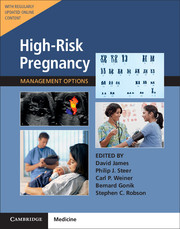Book contents
- Frontmatter
- Contents
- List of Contributors
- Preface
- Section 1 Prepregnancy Problems
- 1 Constitutional and Environmental Factors Leading to a High-Risk Pregnancy
- 2 Domestic Violence in Pregnancy
- 3 Female Genital Mutilation and Pregnancy
- 4 Genetics, Risks of Recurrence, and Genetic Counseling
- Section 2 Early Prenatal Problems
- Section 3 Late Prenatal – Fetal Problems
- Section 4 Problems Associated with Infection
- Section 5 Late Pregnancy – Maternal Problems
- Section 6 Late Prenatal – Obstetric Problems
- Section 7 Postnatal Problems
- Section 8 Normal Values
- Index
3 - Female Genital Mutilation and Pregnancy
from Section 1 - Prepregnancy Problems
- Frontmatter
- Contents
- List of Contributors
- Preface
- Section 1 Prepregnancy Problems
- 1 Constitutional and Environmental Factors Leading to a High-Risk Pregnancy
- 2 Domestic Violence in Pregnancy
- 3 Female Genital Mutilation and Pregnancy
- 4 Genetics, Risks of Recurrence, and Genetic Counseling
- Section 2 Early Prenatal Problems
- Section 3 Late Prenatal – Fetal Problems
- Section 4 Problems Associated with Infection
- Section 5 Late Pregnancy – Maternal Problems
- Section 6 Late Prenatal – Obstetric Problems
- Section 7 Postnatal Problems
- Section 8 Normal Values
- Index
Summary
Introduction
Female genital mutilation (FGM) presents a unique challenge for obstetricians as management encompasses clinical, legal, and safeguarding aspects. Some clinicians will feel confident dealing with FGM and its consequences, having worked in high-prevalence areas. Others, having worked mainly in regions with a low prevalence of FGM, may complete their training without ever seeing a case. The aim of this chapter is to familiarize obstetricians with the law surrounding FGM, the risks posed to pregnant women, and management during pregnancy.
FGM, sometimes known as female circumcision or “cutting,” is defined by the World Health Organization (WHO) as all procedures involving partial or total removal or other injury of the external female genitalia for nonmedical reasons. The degree of harm sustained has been classified into four types by the WHO (Table 3.1).
The practice is prevalent in 29 African countries as well as in parts of the Middle East and Asia. FGM has also been documented in communities in Iraq, Israel, Oman, the United Arab Emirates, the Occupied Palestinian Territories, India, Indonesia, Malaysia, and Pakistan. Communities practicing it believe that it will ensure a girl's proper marriage, chastity, beauty, or family honor. Although no religious group promotes or condones FGM, many perceive it to be a religious requirement, hence its widespread prevalence throughout the world. The practice is often carried out by untrained “circumcisers” in unsanitary conditions without anesthetic. The child is forcibly restrained and instruments such as knives, scissors, and razor blades are used to remove of damage parts or all of the external genitalia. Children are often “circumcised” in groups. Following the procedure, the legs are bound, and if the vaginal orifice has been closed a reed or straw is left in the vagina to allow it and what is left of the labia to heal, leaving a small opening for urination and menstruation. Recent evidence has shown a move towards medicalization of the practice, with children being taken to clinics or medical staff coming to their homes. WHO figures suggest that worldwide over 18% of FGM is performed by healthcare professionals.
- Type
- Chapter
- Information
- High-Risk Pregnancy: Management OptionsFive-Year Institutional Subscription with Online Updates, pp. 46 - 53Publisher: Cambridge University PressFirst published in: 2017



